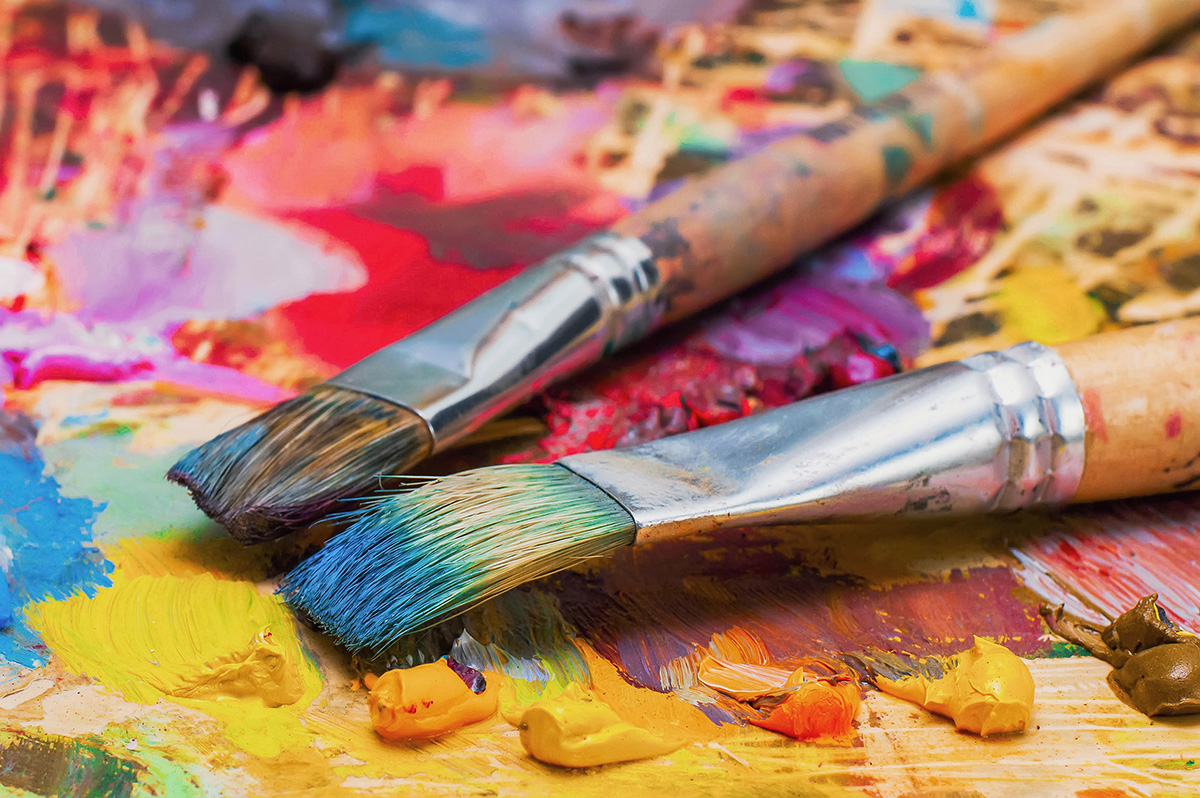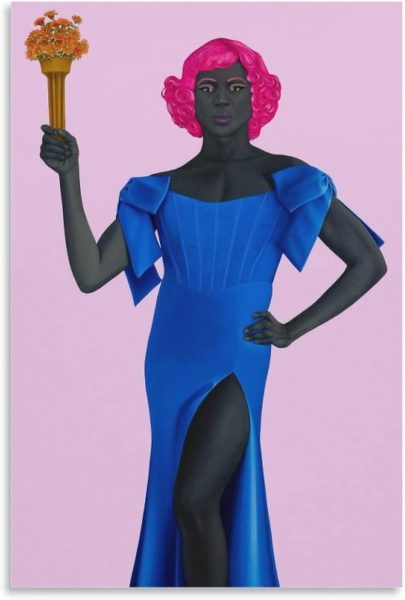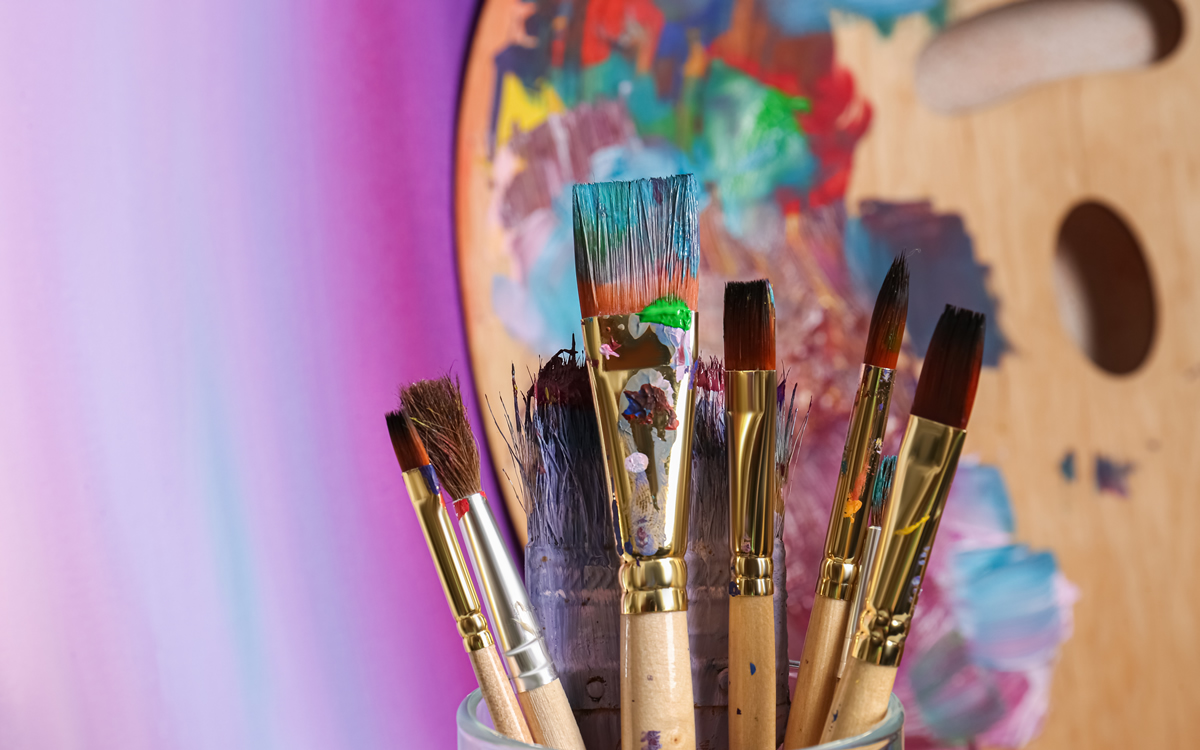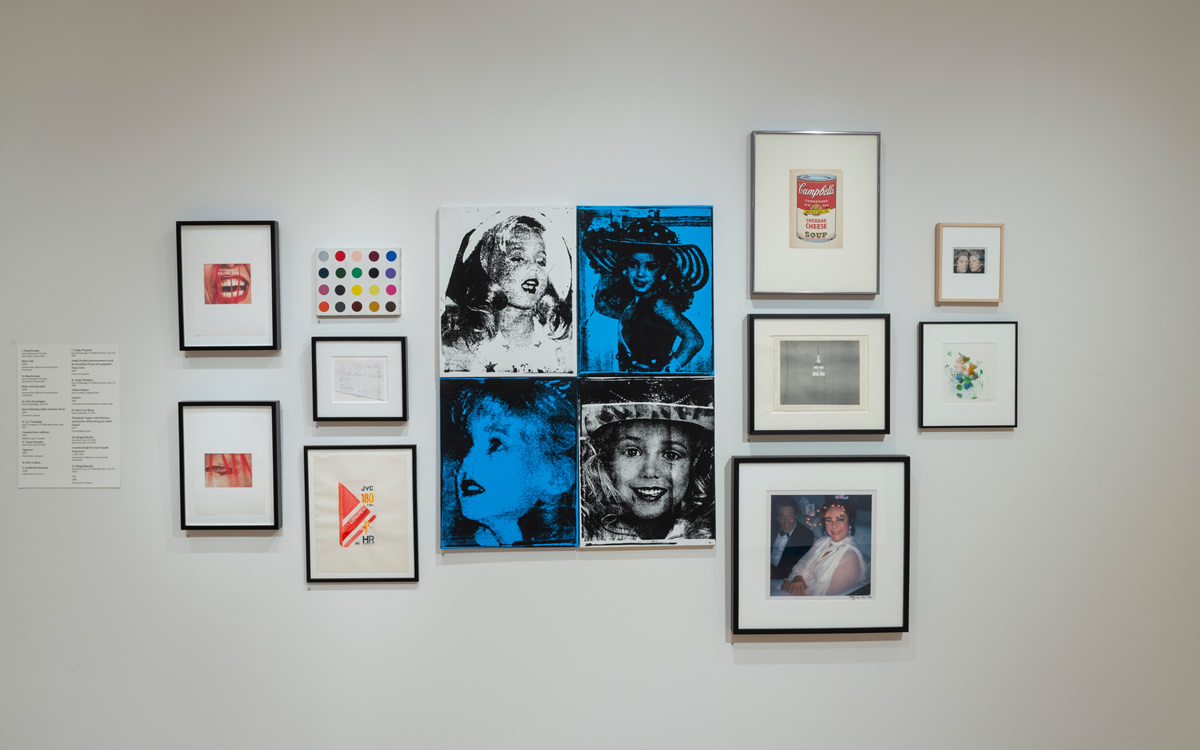Galleries
New gallery opening in D.C.
Dandelion Collective exhibition features works by John Von Sauerhoff

Dandelion Collective, a new space in Columbia Heights for LGBTQ healers and artists, will open on Saturday, Aug. 24 with an opening reception at 2 p.m. at 3417 14th St., N.W.
This first exhibition features the incredible, ethereal artwork of John Von Sauerhoff. His stunning pop surrealist paintings will transport you to another world.
More information is available at dandelioncollectivedc.com/art-gallery.
Galleries
Blockbuster Amy Sherald exhibit opens in Baltimore
Artist has emerged as LGBTQ hero after refusing to cave to censorship

Artist Amy Sherald has emerged as a hero in the LGBTQ community following her controversial decision to pull her blockbuster new exhibit “American Sublime” from the National Portrait Gallery in D.C. and move it to Baltimore after Smithsonian officials sought to censor her painting “Trans Forming Liberty.”
That painting depicts transgender model Arewà Basit as the Statue of Liberty, which conflicts with President Trump’s war on DEI and his efforts to erase transgender people from the American narrative.
Sherald issued a statement over the summer that the Smithsonian had “concerns” about the painting. “These concerns led to discussions about removing the work from the exhibition,” Sherald said in the statement. “While no single person is to blame, it is clear that institutional fear shaped by a broader climate of political hostility toward trans lives played a role.”
She said the Smithsonian had proposed including a video in the exhibit that would “contextualize” the painting and likely include anti-trans views. It was then she announced her decision to pull the exhibit entirely and move it to the Baltimore Museum of Art, a major coup for the museum.

Sherald studied at Baltimore’s Maryland Institute College of Art, which she described as “the best decision I ever made,” during a sold out Q&A on Nov. 2 moderated by the BMA’s director, Asma Naeem. Unfortunately, the subject of censorship and the last-minute decision to move the exhibit to the BMA didn’t come up during the discussion. But Naeem rightly described Sherald as “one of the most important painters of our time.”
“American Sublime,” billed as a mid-career retrospective, features 38 of Sherald’s paintings, including her portraits of former first lady Michelle Obama and Breonna Taylor, along with “Trans Forming Liberty.”
Sherald and Naeem joked throughout the breezy hour-long conversation and reminisced about spending time at MICA and in Baltimore. The artist said she still finds inspiration and even potential portrait subjects in grocery stores and on the streets of Baltimore and New York, where she now lives. Many of the portraits in the exhibit were painted in Baltimore.
Although Sherald and Naeem kept it light and avoided discussing censorship, the one serious and non-negotiable subject Sherald addressed was the paramount importance of integrity. Her insistence on the integrity of the work and the inclusion of trans representation in the exhibit brought her to the difficult decision to pull her work from the Smithsonian. It was a bold and inspiring move in a time when so many public figures, CEOs, and politicians have shown a disappointing and dangerous lack of integrity in the face of an administration that seeks to subvert the Constitution and erode the First Amendment. Sherald stands as a powerful symbol of resistance and, yes, integrity in these dark times. Her refusal to cave to authoritarian impulses and blatant censorship will be remembered for years to come. The nation’s top tech CEOs and congressional leaders should see this exhibit and learn from her brave example.
“American Sublime” is open now through April 5 at the Baltimore Museum of Art and requires a paid ticket for entry. (Admission is free on Thursday evenings and free on Jan. 15 and Feb. 19. The museum is closed Mondays and Tuesdays.) For more information and tickets visit artbma.org.

New England artists Caroline Rufo and John Rufo, also known as RufoArt will open an exhibition on Thursday, Aug. 10 at 6 p.m. at Nepenthe Gallery.
The husband-and-wife duo will share their paintings and also talk about their inspirations. Caroline explores the natural beauty, ideas, and systems of power that create her surroundings while John works toward an understanding of art as a representation of singular moments of both immediate presence and a larger context of wholeness.
For more details, visit Nepenthe Gallery’s website.
Galleries
John Waters introduces the world to his ‘roommates’
Baltimore Museum of Art showcases filmmaker’s eclectic collection in new exhibit

As open as he is about his childhood and his movies and the causes he supports, writer and filmmaker John Waters remains guarded about his personal life.
From Waters’ books, interviews and speaking engagements, fans know that he’s gay and who his longtime friends are. They know he has three residences — in Baltimore, New York, and San Francisco — and that he spends his summers in Provincetown. They know where he plans to be buried, and with whom. But Waters reveals little about his most intimate relationships.
“I have to talk about my movies. I have to give interviews to promote what I’m doing,” he once said. “But no one really knows my personal life. And if you don’t have a personal life, I feel bad for you.”
So it was a bit surprising this fall to hear Waters talk about the “roommates” he lives with, as if he’s a college kid in the freshman dorm, or he’s renting out rooms to cope with inflation.
During a press briefing about a new exhibit at the Baltimore Museum of Art, Waters volunteered that he has roommates in each of his three residences. In many cases, he said, he’s had these roommates for years. And they’re not members of his biological family; he chose to live with them.
But for those hungry for morsels about Waters’ private affairs, these aren’t exactly romantic roommates. The museum event was a preview for “Coming Attractions: The John Waters Collection,” an exhibition of 83 works of contemporary art from Waters’ personal collection, that runs until April 16, 2023. And ‘roommates,’ Waters explained at the briefing and in a “go mobile’ narration that accompanies the show, is the term he uses to refer to the works of art at his different homes.
“My roommates — that’s what I’ve always called my art collection,” he said at the media event.
“I call art my roommates because I live with them,” he explains in the taped narration. “I look at them every day…We live in a commune.”
Waters’ notion of art works as roommates is not new. He wrote about it in a chapter of his 2010 book, “Role Models,” in which he describes the art in his homes as roommates, having traits that he likes and seeks out for all of his homes. He said he prefers the companionship of art-roommates to live ones.
“No sirree, no real-life people sharing my bathroom or reading my newspapers before me!” he vowed. “Instead, I live with artists. Mike Kelley is one of my roommates.”
Visitors to Waters’ homes, including guests at his annual Christmas party in Baltimore, have been lucky enough to see what he’s talking about. The BMA exhibit is the first time he’s shared his companions on such a large scale.
Part of the fun of the exhibit for him, Waters said during a walk-through of the show, has been seeing his roommates from his three different residences, in the same space for the first time, in some cases side-by-side.
“They’ve never met each other before,” he said. “It was like [the curators] were introducing different artists that should have met a long time ago.”
Though he’s perhaps best known for films such as “Hairspray” and “Pink Flamingos,” bestsellers such as “Role Models” and “Carsick,” and nicknames such as “The Pope of Trash” and “The Prince of Puke,” Waters, 76, is also a visual artist and noted art collector.
He was the subject of a retrospective entitled “John Waters: Indecent Exposure” at the BMA and the Wexner Center for the Arts in Columbus, Ohio, in 2018 and 2019. He has two works on view in the inaugural show at the Rubell Museum that recently opened in Washington, D.C., “Beverly Hills John” and “Shoulda!”
The 83 works on view in “Coming Attractions” were culled from a larger group of about 375 works that Waters, a Baltimore native and BMA trustee, has agreed to leave to the museum when he dies.
Waters’ gift to the BMA includes 288 works by 125 artists other than himself, in a variety of art forms. Waters also donated 87 prints, sculptures, mixed-media and video pieces that he created. His gift will make the BMA the greatest single repository of his visual artwork and will enable it to provide, in perpetuity, a comprehensive view of his vision and approach to making and collecting art.
When Waters’ gift was announced in 2020, directors promised the museum would have a preview of what’s to come while he was still alive, and this is it. All of the works in the show are on loan from Waters and will go back to him when the show is over.
In return for his gift, the museum board said it would name restrooms and a rotunda after him. That wasn’t a putdown. Known for his raunchy humor and offbeat way of thinking, Waters specifically asked to have his name on the restrooms, the first at the BMA that are “all gender.”
Christened last fall with a “first pee” by trans artist and activist Elizabeth Coffey, The John Waters Restrooms are right next to The Nancy Dorman and Stanley Mazaroff Center for the Study of Prints, Drawings and Photographs, where “Coming Attractions” opened on Nov. 20. The museum has also agreed to display prominently five works from the collection, including one by Waters, at all times.
“Coming Attractions” is one of two Waters-related museum exhibits opening over the next year, along with “Pope of Trash,” a career retrospective at the Academy Museum of Motion Pictures in Los Angeles in 2023. Dates for the retrospective have not been announced.
Unlike “Indecent Exposure” three years ago, “Coming Attractions” doesn’t include works by Waters. Instead, it provides an insider’s look at his tastes in contemporary art, and how he lives with art, by focusing on works by others that he has collected and displayed at his homes in Baltimore, New York, and San Francisco.
The guest curators are photographer Catherine Opie and multi-media artist Jack Pierson, both of whom have been friends with Waters for years and are represented in his collection. Both identify as queer, as do many of the artists represented in the exhibit. The show is organized by Leila Grothe, the museum’s Associate Curator of Contemporary Art.
Among the featured works are paintings, sculptures, photographs, and prints by Diane Arbus; Nan Goldin; Mike Kelley; Cindy Sherman; Cy Twombly; Andy Warhol; Christopher Wool, Gary Simmons and others.
The museum refers to the exhibit as “a cutting-edge articulation of American individualism, particularly as it relates to queer identity and freedom of expression.”
“All of John has been a go-to for me, as a young queer,” said Opie, who has a portrait of Waters in the show. The works “represent a type of contemporary art that the museum actually just doesn’t really have,” Grothe said.
Waters’ collection is a reflection of his personality and imagination, Opie and Pierson said in a joint statement.
“Our hope is to share with audiences another aspect of John’s creative vision by offering a glimpse into what he values: artists who are unafraid to take risks, who do not compromise, and who create their art on the margins.”
The roommate reference could have been a one-liner, but Waters takes the idea and runs with it, building on what he wrote in his Roommates chapter in “Role Models.”
“They delighted me or made me angry or made me laugh or I thought did something in a new way,” he said of his companions. “They just challenged me and I wanted to live with them because art’s your roommates. You live with them forever.”
In talking about his ‘roommates,’ Waters makes it seem as if they are sentient beings who have minds, feelings and personalities of their own, and who can interact with each other, perhaps when the museum is closed.
He paints a picture of his roommates being the art world equivalent of the robotic “hosts” in HBO’s “Westworld,” or the exhibits from “Night at the Museum” and its sequels, movies in which works of art come to life.
Waters talks about his roommates hanging out together, knowing they’re in the home of the Cone Collection with its priceless paintings by Henri Matisse and other masters. He thinks about how they’re adjusting to their temporary home. He muses about them developing relationships they couldn’t have in the different residences and becoming friends. He imagines his roommates plotting with each other. He fantasizes about them sneaking out of the gallery they’re in and exploring other parts of the museum.
Asked at a donors’ event how he thinks his roommates are getting along in their new setting, Waters didn’t miss a beat: “I think they’re so happy to meet each other,” he said. “And they all want to gang up and scare The Blue Nude.”
It’s not that much of a stretch to think in those terms, since many of the works in Waters’ collection are images either of his friends (the late Cookie Mueller), or by his friends (Vincent Peranio), or both (Susan Lowe’s drawing of Mink Stole.)
The curators are going along with it, too, talking about ‘introducing’ different works so they can be “in conversation’ with each other.
“John delights in the fact that these works, all pulled from different homes, are meeting each other for the first time,” Grothe said at the press preview, pointing to a wall with works from three different residences.
“How great does this wall look with Richard Tuttle on the left, the sculpture by Vincent Fecteau in the center, and Gary Simmons on the right?” she asked. “There’s a lot to say about each artwork, but for now we should just appreciate the budding of a new friendship between these pieces.”
The curators positioned certain works to show how they “begin to speak to one another in different ways,” Opie said. “Throughout the exhibition, you’ll notice these little groupings…that we ended up putting together so that they could have a conversation.”
Was anyone left out of the party?
Pierson said he regrets that there isn’t an “Edith Massey moment” in the show, in honor of the character who played Edith the Egg Lady in “Pink Flamingos,” so her voice could be part of the mix. “I’m sure I could have found one,” he said.
“The only piece that would remind me of her [is one] that I didn’t buy but I wish I did, by George Stoll,” Waters said. “He made fake Easter eggs, but the collector hides them in their house so no one ever sees them. And you forget them, yourself, that you have them. And then you’re going through an old drawer – Oh! There’s a piece of art I bought!”
During the donors’ event, Grothe asked Waters what his homes feel like with much of the art out on loan. She said people at the museum are worried about him, living without his roommates. Waters said his homes look and feel empty.
“It looks like I’m moving, everywhere, because they didn’t take everything,” he said. “So there are big holes in the wall, and dirt.”
Waters said he keeps thinking Louise Lawler should come over, a reference to the artist who’s made a career of studying and documenting art installations. “It’s a great installation for her to do.”
Waters went even further in the taped narration, likening his residences to scenes of a crime, still in disarray.
“They have come to all my homes and taken half the stuff off the walls,” he laments. “So now I live in abandoned squats that look like art robberies happened in my house.”
At the same time, he admits, his roommates look good in their museum setting.
“You can see them so much better,” he said. “I don’t have good lighting. They cleaned them, too. They were dirty, some of them.”
Even though the show just opened, Waters is already thinking about what happens after it comes down.
“It’s weird,” he said. “It’s going to be hard to put them back where they went after seeing them in here together.”
Waters said he thought about putting his roommates back differently, taking cues from the exhibit and preserving some of the new ‘relationships’ formed at the museum. He said he‘s grateful to the curators for coming up with “a whole new way” to show them off.
“Maybe I’m going to never be able to hang it back the way it was [and] have to put it back the way you did it,” he told the curators at one point.
But ultimately, he said, he decided against shifting everything around.
“Oh god, that would really be complicated,” he said. “I’d have to move all the furniture and change everything. So they will go back, lonely.”
Waters said he knows that won’t be as much fun for his roommates, not hanging with their new friends. But he notes this isn’t the last time they’ll see each other, since they’ll be returning to the museum eventually.
After all, he said, “they know that way later, after I’m dead, they’ll get together again.”
-

 District of Columbia3 days ago
District of Columbia3 days ago‘Sandwich guy’ not guilty in assault case
-

 Sports3 days ago
Sports3 days agoGay speedskater racing toward a more inclusive future in sports
-

 Celebrity News5 days ago
Celebrity News5 days agoJonathan Bailey is People’s first openly gay ‘Sexiest Man Alive’
-

 Michigan5 days ago
Michigan5 days agoFBI thwarts Halloween terror plot targeting Mich. LGBTQ bars














